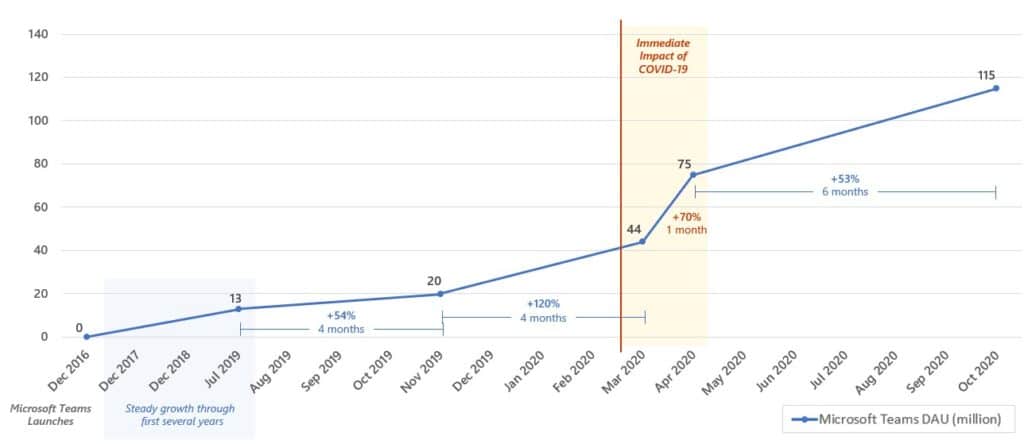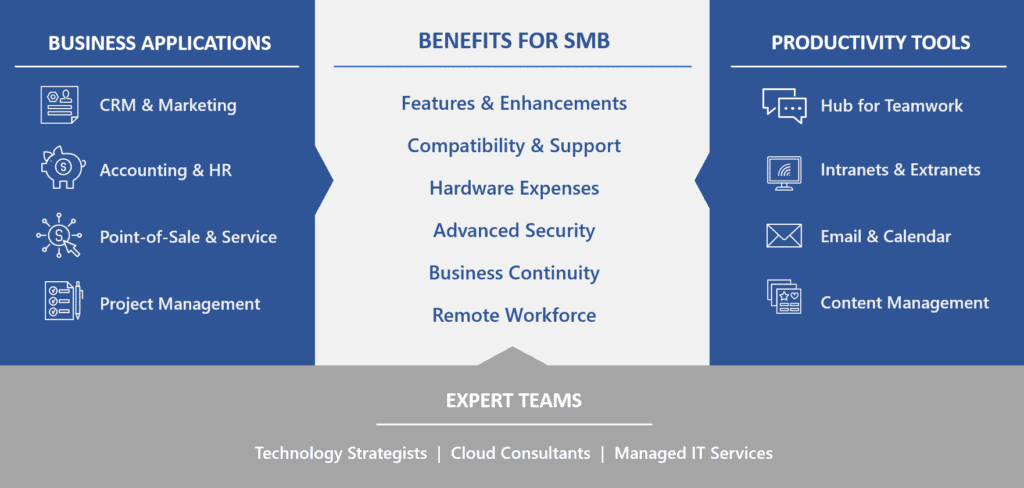Rapid (and abrupt) digital transformation
Over the past ten months (2020 leading into 2021), we have all experienced a rapid (and abrupt) transformation to digital everything, impacting nearly every activity in our daily work-lives. The most obvious of these everyday work activities are meetings. Whether with co-workers, customers, prospects, teams, vendors, or even conferences, discussions with others are at the heart of business operations. Beyond meetings are the other “workloads” in our daily professional routines which—if they weren’t already digital or going digital—were propelled into doing so starting around March 2020.
Although companies of all sizes experienced challenges from this urgent need to adapt, it poses unique challenges and creates new opportunities for small and medium-sized businesses (“SMBs”). SMBs tend to be much more agile and resilient, but they also face more significant financial pressures and different risks than their enterprise-sized counterparts.
What SMBs need today
We see SMBs having three critical areas of focus:
-
- Ability to contain (and reduce) costs – 68% of U.S. small and medium-sized businesses have reduced spending.
- Protection from new and unseen risks, including cybersecurity threats – With an average cost of a security attack at $149,000, SMBs must be able to protect themselves effectively.
- Productivity from a remote workforce – According to surveys, SMBs are operating with approximately 40% fewer employees now than at the beginning of 2020. With a significantly reduced workforce, the need to enable and ensure productivity from remote workers is more important than ever.
Global shift to remote everything
Whether you have been using Microsoft Teams, Zoom, WebEx, or another conferencing platform, you can bet that they all experienced drastic usage increases in 2020.
For example, consider Microsoft Teams’ subscription increase in the latter half of 2019 and early 2020—approximately 54% in four months of 2019 and 120% at the end of 2019/beginning of 2020. Compare that to the ONE MONTH increase of 70% between March and April 2020, followed by 53% more through October 2020.
As Microsoft’s CEO, Satya Nadella, stated in May 2020, “We saw two years of digital transformation in two months.”
SMBs and their adoption of the cloud
How does all of this relate to the topic of outsourcing? Traditionally, you may think of outsourcing as hiring external people or companies to perform specific services for your organization—such as human resources/payroll/benefits administration; marketing/advertising; finance/accounting; or IT management/application development/support. However, moving certain technology capabilities (or workloads) to cloud-based services is another form of outsourcing. It affords SMBs, in particular, a way to offload critical technology functions so that they can focus on the core product or service of their business. In most cases, it also provides SMBs access to “enterprise-level” technology but much more cost-effectively.
Based on a Flexera 2020 State of the Cloud Report, SMBs are adopting public cloud services more quickly than enterprises. Approximately 70% of SMB technology and data will reside in a public cloud (i.e., Microsoft, AWS, or Google) within the next 12 months compared to approximately 55-60% for enterprises.
Furthermore, 50% of SMBs believe that the past year’s events (specifically the COVID-19 pandemic) will increase their cloud usage as we continue into 2021 either slightly or significantly over what they initially planned.
Benefits of outsourcing to the cloud
There are two essential categories of technologies to consider moving to or running in the cloud.
-
- Business applications – Developed, maintained, and hosted by 3rd-party companies (i.e., Software as a Service or SaaS), these applications may serve core business functions such as CRM, HR/payroll, Accounting, Point-of-Sale, etc., or be industry-specific. These can also be proprietary or custom-built applications for your company or industry that can leverage cloud-hosted services, such as Microsoft Azure.
- Productivity tools – These are the standard tools that “information workers” use day in and day out to perform their tasks and collaborate with other workers. These tools include e-mail and calendars, secure intranets and extranets, hubs to facilitate collaborative teamwork, and platforms for managing various types of content, including structured and unstructured data.
The many benefits of outsourcing these workloads to the cloud include:
-
- Features and enhancements – Especially in the case of 3rd-party-maintained (SaaS) solutions, organizations never have to worry about having the latest features and enhancements for their business applications or costly upgrades to newer software versions.
- Compatibility and support – Cloud-based solutions are web-based, and most (if not all) provide support for all of the popular web browsers and many device types (e.g., laptops, tablets, and mobile devices).
- Hardware expenses – Reduce or eliminate the need for expensive, internal hardware purchases and on-going maintenance beyond employee devices.
- Advanced security – Cloud platforms and applications are very likely to be more secure than anything most organizations have running in their on-premises environment—whether the application is running on an internal server, an employee’s laptop, or even a computer underneath an office desk.
- Business continuity – Cloud-based solutions, applications, and productivity platforms are running in data centers (across many data centers in most cases to provide regional experiences). These data centers have processes that ensure nearly 100% uptime and offer better protection against data loss, failures of any kind, and even natural disasters.
- Remote workforce enablement – As we see demand continue to rise, ensure access to your critical applications, data, and tools from anywhere at any time.
Leveraging experts
In a recent Greater North Fulton Chamber of Commerce (www.gnfcc.com) panel discussion for SMBs on the benefits of outsourcing, an attendee poll showed that access to experts was one of the top three reasons companies outsource. We have heard for a few years now that “all companies are technology companies these days” because we all rely on technology and IT resources. However, technology is not necessarily your company’s core product or service. Wherever you are on your cloud journey, there are expert teams ready to help you maximize your investment in the cloud.
This Abel Insight was written by Abel Solutions’ President, David Hammond.










